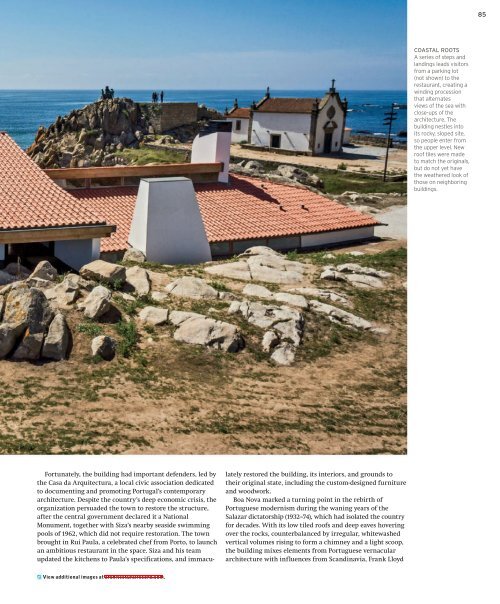Architectural Record 2015-02
You also want an ePaper? Increase the reach of your titles
YUMPU automatically turns print PDFs into web optimized ePapers that Google loves.
85<br />
COASTAL ROOTS<br />
A series of steps and<br />
landings leads visitors<br />
from a parking lot<br />
(not shown) to the<br />
restaurant, creating a<br />
winding procession<br />
that alternates<br />
views of the sea with<br />
close-ups of the<br />
architecture. The<br />
building nestles into<br />
its rocky, sloped site,<br />
so people enter from<br />
the upper level. New<br />
roof tiles were made<br />
to match the originals,<br />
but do not yet have<br />
the weathered look of<br />
those on neighboring<br />
buildings.<br />
Fortunately, the building had important defenders, led by<br />
the Casa da Arquitectura, a local civic association dedicated<br />
to documenting and promoting Portugal’s contemporary<br />
architecture. Despite the country’s deep economic crisis, the<br />
organization persuaded the town to restore the structure,<br />
after the central government declared it a National<br />
Monument, together with Siza’s nearby seaside swimming<br />
pools of 1962, which did not require restoration. The town<br />
brought in Rui Paula, a celebrated chef from Porto, to launch<br />
an ambitious restaurant in the space. Siza and his team<br />
updated the kitchens to Paula’s specifications, and immaculately<br />
restored the building, its interiors, and grounds to<br />
their original state, including the custom-designed furniture<br />
and woodwork.<br />
Boa Nova marked a turning point in the rebirth of<br />
Portuguese modernism during the waning years of the<br />
Salazar dictatorship (1932–74), which had isolated the country<br />
for decades. With its low tiled roofs and deep eaves hovering<br />
over the rocks, counterbalanced by irregular, whitewashed<br />
vertical volumes rising to form a chimney and a light scoop,<br />
the building mixes elements from Portuguese vernacular<br />
architecture with influences from Scandinavia, Frank Lloyd<br />
View additional images at architecturalrecord.com.


















